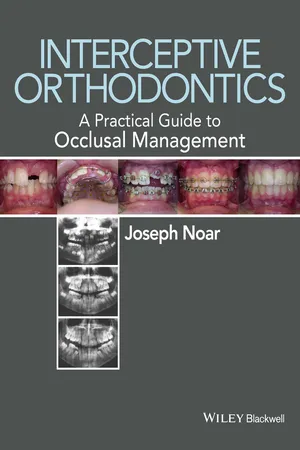
- English
- ePUB (mobile friendly)
- Available on iOS & Android
About This Book
Identify problems and introduce solutions early for an ideal aesthetic result Interceptive Orthodontics: A Practical Guide to Occlusal Management aims to guide the practitioner in the art of interceptive management of the developing dentition. The goal is to guide the permanent dentition into the line of the dental arches, avoiding complex orthodontic treatment for teeth displaced far from their ideal position, and thereby reducing orthodontic treatment time. This book covers growth of the jaws and tooth development, and explains the correct timing of interceptive management. It also discusses orthodontic assessment, special investigations and comprehensive management of the mixed dentition, taking in the issues of early crowding, impaction, supernumerary and supplemental teeth, dental arch expansion, space maintenance and space management. In line with best available evidence, it provides clear treatment objectives and detailed treatment planning advice. Practical, accessible and illustrated with a wealth of colour images, this is an ideal clinical companion for general dental practitioners, oral surgeons, paediatric dentists and orthodontists. It is also a valuable reference for all training grades.
Frequently asked questions
Information
CHAPTER 1
Introduction
What Do We Know about Growth?

Growth and Development of the Jaws
- growth mechanisms (how new bone is formed);
- growth pattern (change in size and shape of the bone);
- growth rate (speed at which the bone is formed);
- regulating mechanism that initiates and directs the above three factors.
Growth Mechanisms
- endochondral ossification: growth and ossification of a cartilage model;
- intramembranous ossification: transformation of mesenchymal connective tissue and deposition of bone on existing bone surfaces.
Growth of the Cranial Base
Growth of the Mid-Face
Growth of the Mandible
Table of contents
- Cover
- Table of Contents
- Dedication
- Title page
- Copyright page
- Preface
- CHAPTER 1: Introduction
- CHAPTER 2: Recognising the Problem
- CHAPTER 3: Investigations
- CHAPTER 4: Managing the Developing Occlusion
- Index
- End User License Agreement